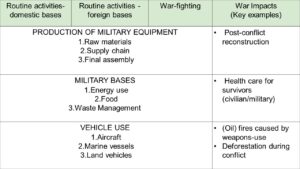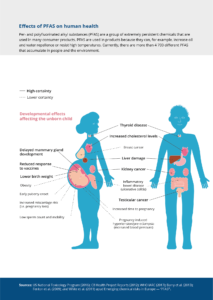
by Sarah Alcantara, Harel Umas-as & Chrystel Manilag, World BEYOND War, March 20, 2022
The Culture of Militarism is one of the most ominous threats in the 21st Century, and with the advancement of technology, the threat grows larger and more imminent. Its culture has shaped the world to what it is today and what it presently suffers from – racism, poverty, and oppression as history is riddled extensively in its culture. While the perpetuation of its culture has profoundly affected humanity and modern society, the environment is not spared from its atrocities. With more than 750 military bases in at least 80 countries as of 2021, the United States of America, which has the largest military in the world, is one the major contributors of the world’s climate crisis.
Carbon Emissions
Militarism is the most oil-exhaustive activity on the planet, and with advanced military technology, this is bound to grow faster and bigger in the future. The U.S military is the largest consumer of oil, and analogously the largest producer of greenhouse gases in the world. With more than 750 military installations world-wide, fossil fuels are required to power bases and to keep these installations running. Question is, where do these tremendous amounts of fossil fuels go?

Parkinson’s Components of the Military Carbon Boot-Print
To help put things into perspective, in 2017, the Pentagon’s produced 59 million metric tons of Greenhouse Gases emissions dwarfing countries such as Sweden, Portugal, and Denmark altogether. Similarly, in 2019, a study conducted by Durham and Lancaster University researchers established that if the U.S. military in itself were to be a nation state, it would be the 47th largest emitter of greenhouse gases in the world, consuming more liquid fuels and emitting more CO2e than most countries – making the institution one of the largest climate polluters in all of history. Case in point, one military jet, the B-52 Stratofortress’ fuel consumption in an hour is equal to an average car driver’s fuel consumption in seven (7) years.
Toxic chemicals and water contamination
One of the most common environmental damages military bases have is toxic chemicals mainly water contamination and PFAs which are labeled to be ‘forever chemicals’. According to Centers of Disease Control and Prevention, Per- and Polyfluorinated Substances (PFAS) are used “to make fluoropolymer coatings and products that resist heat, oil, stains, grease, and water. Fluoropolymer coatings can be in a variety of products.” What exactly makes PFAs dangerous to the environment? First, they do not break down in the environment; Secondly, they can move through soils and contaminate drinking water sources; and finally, they build up (bioaccumulate) in fish and wildlife.
These toxic chemicals directly affect the environment and wildlife, and analogously, human beings who have regular exposure to these chemicals. They can be found in AFFF (Aqueous Film Forming Foam) or in its simplest forms a fire extinguisher and used in the event of a fire and jet fuel within a military base. These chemicals may then spread through the environment through the soil or water around the base which then poses a wide range of threats to the environment. It is ironic when a fire extinguisher is made to solve a certain problem yet that “solution” seems to be causing more problems. The infographic below was provided by the Europe Environment Agency along with other sources that presents several diseases that PFAS can cause on both adults and unborn children.

Photo by Europe Environment Agency
Still, despite this detailed infographic, there are still many things to be learned on PFAS. All of these are acquired through water contamination in water supplies. These toxic chemicals also have a huge effect on agricultural livelihoods. For instance, in an article on September, 2021, over 50 000 farmers in several states in the U.S., have been contacted by the Development of Defense (DOD) because of the possible spread of PFAS on their groundwater from nearby US military bases.
The threat of these chemicals are not gone once a military base is already abandoned or unmanned. An article for the Center of Public Integrity gives an example of this as it talks about George Air Force base in California and that it was used during the Cold War and was then abandoned in 1992. Yet, PFAS is still there through water contamination (PFAS is said to be still found in 2015).
Biodiversity and Ecological balance
The effects of military installations around the globe has not only exclusively affected humans and the environment but also biodiversity and the ecological balance in itself. The ecosystem and wildlife is one of the many casualties of geopolitics, and its impacts on biodiversity has been overwhelmingly harmful. Overseas military installations have endangered the flora and fauna exclusive from its regions. Case in point, the US government recently announced their intent on shifting a military base to Henoko and Oura Bay, a move that will cause long-lasting effects on the ecosystem in the region. Both Henoko and Oura Bay are hotspots of biodiversity and home to more than 5,300 species of corals, and the critically endangered Dugong. With no more than 50 surviving Dugongs in the bays, the Dugong is expected to face extinction if no immediate actions are taken. With the military installation, the environmental cost of the loss of species endemic to Henoko and Oura Bay will be extreme, and those locations will ultimately suffer a slow and painful death in a few years’ time.
Another example, The San Pedro River, a northward flowing stream that runs near Sierra Vista and Fort Huachuca, is the last free-flowing desert river in the South and home to rich biodiversity and many endangered species. The groundwater pumping of the military base, Fort Huachuca however, is causing harm to the San Pedro River and its endangered wildlife such as the the Southwestern Willow Flycatcher, Huachuca Water Umbel, Desert Pupfish, Loach Minnow, Spikedace, Yellow-billed Cuckoo, and the Northern Mexican Garter Snake. Due to the installation’s excessive local groundwater pumping, water is being seized to supply coming either directly or indirectly from the San Pedro River. As a result, the river is suffering alongside this, because it is the dying rich ecosystem that relies on the San Pedro River for its habitat.
Noise Pollution
Noise Pollution is defined as the regular exposure to elevated sound levels that could be potentially hazardous to humans and other living organisms. According to the World Health Organization, regular exposure to sound levels of no more than 70 dB are not harmful to humans and living organisms, however, exposure to more than 80- 85 dB over a prolonged period of time is harmful and may cause permanent hearing damage – military equipment such as jet planes have an average of 120 dB at proximity meanwhile gunshots have an average of 140dB. A report by the Veterans Benefits Administration of the U.S. The Department of Veterans Affairs showed that 1.3 million veterans were reported to have hearing loss and another 2.3 million veterans were reported to have tinnitus – a hearing disability characterized by the ringing and buzzing of the ears.
Additionally, humans are not the only ones vulnerable to the effects of noise pollution, but also animals. The Okinawa Dugong for instance, are critically endangered species native to Okinawa, Japan with highly sensitive hearing and are currently threatened with the proposed military installation in the Henoko and Oura Bay whose noise pollution will cause immense distress worsening the threat of the already endangered species. Another example is the Hoh Rain Forest, Olympic National Park which is home to two dozen animal species, many of which are either threatened and endangered. Recent study shows that the regular noise pollution military aircrafts produce affects the tranquility of the Olympic National Park, jeopardizing the ecological balance of the habitat.
The Case of Subic Bay and Clark Air Base
Two of the prime examples of how military bases affect the environment on social and individual levels are the Subic Naval Base and Clark Air Base, which left behind a toxic legacy and left a trail of people who suffered the consequences of the agreement. These two bases are said to have contained practices that damaged the environment as well as accidental spills and toxic dumping, allowing harmful and dangerous effects to humans. (Asis, 2011).
In the case of Subic Naval base, a base built from 1885-1992 by multiple countries but mainly by the U.S., was already abandoned yet continued to become a threat to Subic Bay and its residences. For instance, an article in 2010, stated a certain case of an elderly Filipino who died of lung disease after working and being exposed to their local landfill (where the wastes of the Navy goes to). Additionally, in 2000-2003, there were 38 deaths recorded and were believed to be linked to the contamination of Subic Naval Base, however, due to lack of support from both Philippine and American government, there were no further assessments conducted.
On another hand, the Clark Air Base, a U.S. military base built in Luzon, Philippines in 1903 and later abandoned in 1993 due to Mt. Pinatubo’s eruption has its own share of deaths and illnesses among locals. According to the same article earlier, it was discussed that after Mt. Pinatubo’s eruption in 1991, out of the 500 Filipino refugees, 76 people passed away while 144 others fell to illness due to Clark Air Base’ toxins mainly through drinking from contaminated wells with oil and grease and from 1996-1999, 19 children were born with abnormal conditions, and illnesses also due to the contaminated wells. One particular and notorious case is the case of Rose Ann Calma. Rose’s family was part of the refugees who were exposed to the contamination in the base. Being diagnosed with severe mental retardation and Cerebral Palsy has not allowed her to walk or even speak.
U.S. Band-aid solutions: “Greening the military”
In order to combat the devastating environmental cost of the U.S. military, the institution thus offers band-aid solutions such as ‘greening the military’, however according to Steichen (2020), greening the U.S. military is not the solution due to the following reasons:
- Solar energy, electric vehicles, and carbon neutrality are admirable alternatives for fuel-efficiency, but that does not make war less violent or oppressive – it does not deinstitutionalize war. Hence, the problem still exists.
- The U.S. military is inherently carbon-intensive and deeply intertwined with the fossil fuel industry. (For e.g. Jet fuels)
- The U.S. has an extensive history of fighting for oil, hence, the purpose, strategies, and activities of the military remain unchanged to further continue the fossil-fueled economy.
- In 2020, the budget for the military was 272 times larger than the federal budget for energy efficiency and renewable energy. The funding monopolized for the military could have been used to address the climate crisis.
Conclusion: Long term solutions
- Closure of overseas military installations
- Divestment
- Propagate a culture of peace
- Put an end to all wars
The thought of military bases as contributors to environmental problems is generally left out of discussions. As stated by UN Secretary General Ban Ki-Moon (2014), “The environment has long been a silent casualty of war and armed conflict.” Carbon emissions, toxic chemicals, water contamination, biodiversity loss, ecological imbalance, and noise pollution are only a few of the many negative effects of military base installations – with the rest having yet to be discovered and investigated. Now more than ever, the need to raise awareness is urgent and critical in safeguarding the future of the planet and its inhabitants. With ‘greening the military’ proving to be ineffective, there is a call for the collective effort of individuals and groups all around the world to devise alternative solutions to end the threat of military bases towards the environment. With the help of different organizations, such as World BEYOND War through its No Bases Campaign, the achievement of this goal is far from impossible.
Learn more about World BEYOND War here.
Sign the Declaration of Peace here.








